Museum of the Origins of Man
POST-PALEOLITHIC THREE-DIMENSIONAL ART
HUMAN HEADS WITH AND WITHOUT BODIES IN POST-PALEOLITHIC SCULPTURE
The representation of human heads in the first post-Paleolithic epochs had a religious purpose, as did representation of the entire human figure with clothing.
Later in antiquity, in a gradual process, sculpture, besides being beautiful, also assumed decorative functions – at first in temples, then in residences of kings and influential people, and finally in bourgeois and working-class residences.
From an evolutionary point of view the typologies of human representations in sculpture increase considerably over time, in part due to the growth in the world’s population.
We find the greatest diffusion of sculpture in toys and furnishings.
Contemporary art – that of art exhibitions and modern art museums – has strong expressive and psychological motivations, although from a typological point of view it is decorative art.
Paleolithic art covers a period of three million years with sculpture (three-dimensional art), while paintings (two-dimensional art) begin only 30,000 years ago.
The post-Paleolithic art began about 10,000 years ago. However, in various regions of the world Paleolithic art continued for several millennia, evolving in various ways.
In the Paleolithic material stone and more rarely bone and ivory was used for the sculptures.
In the Neolithic and Metal Ages new materials were adopted, new working techniques were invented, and art increased its functions.
Among the new materials were kneaded earth, kneaded and baked earth (ceramics), copper, bronze, gold and shortly after also glass, which is molten sand. Ceramics were painted with anthropomorphic, zoomorphic, vegetable and geometric subjects and decorations.
In recent times there has been a remarkable increase in new materials and new uses; the sacred depictions of many existing religions in the world continue, in parallel with new types of sculptures produced in large quantities. For their execution, innovative materials are used, such as many types of plastic, rubber, fabrics, iron and aluminum.
With these new materials art, toys and three-dimensional furnishings are made, which fall within the tradition of Paleolithic sculpture.
Tradition is closely linked to evolution, just as the child “evolves” into an adult, and has a complex composition, the components of which evolve separately and with different rhythms.
For example, many current depictions of human beings with animal heads, which entertain us in toys and comics, can be connected, as an image, to the ancient divinities with human body and animal head, while having a different function.
In the scientific analysis of art, which also includes toys, it is necessary to consider that they are beautiful for children, just as the works of art of every period are beautiful for adults. It should also be borne in mind that current toys are designed by adults who are often artists.
In the analysis of the evolution of art, therefore, beauty should not be evaluated for its high economic value. The components of a typology should be analyzed regardless of whether one work of art is more pleasing than another.
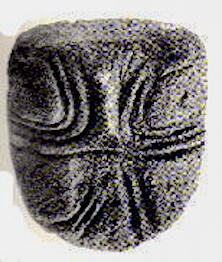
Fig. 4A1) Sculpture in limestone representing a human head (but it could be an artistic man-animal hybrid, possibly a feline). The technique of working includes sculpting of the head shape and engraving to represent the eyes, nose and mouth. The style, that is the stylistic language of the art fashionable at that time, completely invents this head (in other publications it is published upside down, in which case it has no mouth and wears a hat).
In the various books consulted, this sculpture bears the caption “small mask in basalt”. In our opinion the denomination “mask” is improper for two reasons: 1) the sculpture certainly represents a divinity, and we must consider that Natufian art was tied to ritual practices; 2) it cannot be worn.
Height: 3.1 inches. Width: 2.5 inches.
Origin: Eynan, Israel.
Location: Metropolitan Museum of Art, New York.
Dating: 10,000 B.C. approx.
Material culture: Epipaleolithic (Natufian culture).
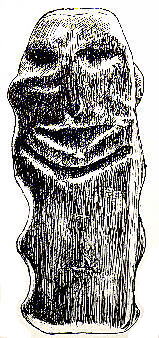 Fig. 4A2) Wooden sculpture in oak (drawing). It represents a human head with a body.
Fig. 4A2) Wooden sculpture in oak (drawing). It represents a human head with a body.
It was found under a thin layer of peat. It is perhaps the oldest known wooden sculpture in Western Europe.
In the Middle East, in the same period, art and religion had made enormous progress, so much so that this beautiful sculpture, in comparison to them, seems primitive to us.
Height: 4.8 inches. Width: 2 inches.
Origin: Volkerak, Willemstad, Noord-Brabant, Holland.
Material culture: Upper Mesolithic.
Absolute dating: 4,450 BC approx.
Location: Rijksmuseum van Oudheden, Leiden, Holland.
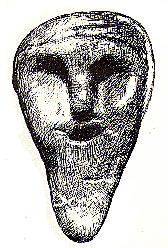 Fig. 4A3) Amber sculpture (drawing) representing a human head with a neck.
Fig. 4A3) Amber sculpture (drawing) representing a human head with a neck.
This sculpture comes from the same deposit in which a zoomorphic sculpture in amber was found (Fig. 7A1),
and both are of similar type to others of the Acheulean and Final Clactonian and Mousterian. So in terms of artistic composition, and perhaps religion, they had not progressed for at least 250,000 years.
Size: very small. Incidentally, we observe that in art texts it is common practice to not indicate the size!
Origin: Northern Europe.
Material culture: Neolithic.
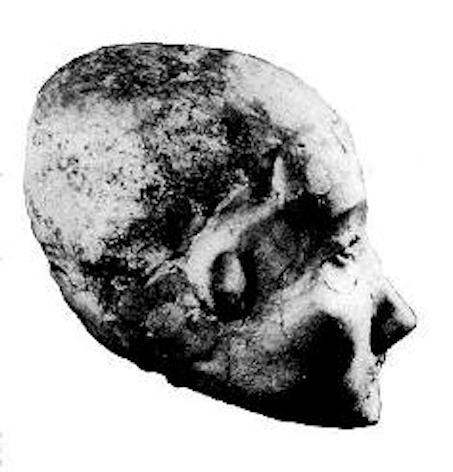 Fig. 4A4) Clay sculpture. Human head. The face is modeled on a human skull; the nose was reconstructed with clay, the empty orbits are filled with clay. The eyes were made with shells from the nearby Red Sea, and the central fissures represent the pupils. On some of these sculptures were found traces of color.
Fig. 4A4) Clay sculpture. Human head. The face is modeled on a human skull; the nose was reconstructed with clay, the empty orbits are filled with clay. The eyes were made with shells from the nearby Red Sea, and the central fissures represent the pupils. On some of these sculptures were found traces of color.
These sculptures made from the skulls of deceased relatives were buried under the floor of houses, and were usually separated from the rest of the skeleton.
The custom of plastering skulls with clay was also widespread in Syria and Turkey.
Origin: Tel es-Sultan (Jericho), Palestine.
Absolute dating: from 9,000 to 8,400 years ago.
Location: Archaeological Museum, Amman. Jordan.
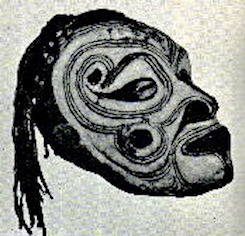 Fig. 4A5) Clay sculpture. Human head. The face is modeled on an ancestor skull, and is painted red and white.
Fig. 4A5) Clay sculpture. Human head. The face is modeled on an ancestor skull, and is painted red and white.
Origin: Sepik River, New Guinea.
Dating: 6,000 BC.
(see Fig. 4A4 e 4A6)
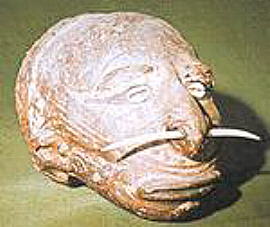 Fig. 4A6) Clay sculpture. Human head. It is a trophy skull remodeled with clay and painted.
Fig. 4A6) Clay sculpture. Human head. It is a trophy skull remodeled with clay and painted.
Origin: Solomon Islands.
Location:Florence Anthropology and Ethnology Museum, founded by Paolo Mantegazza in 1869, of whom we cite this reflection: “The physiological analysis of the idea of truth is so delicate and scabrous, that the obstinate study of many centuries has not yet been enough to give us a sure and uncontroversial definition.” -- P. Mantegazza (1831 - 1910).
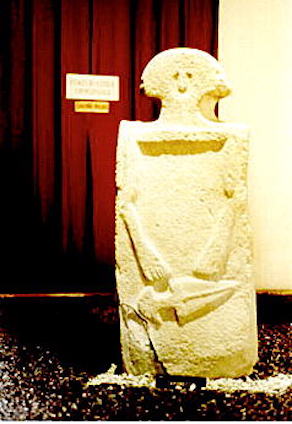 Fig. 4A7) Stone sculpture representing a man armed with a “dagger axe”. The stylistic deformation is of geometric type, and is a local aspect of a “fashion” diffused also in southern France.
Fig. 4A7) Stone sculpture representing a man armed with a “dagger axe”. The stylistic deformation is of geometric type, and is a local aspect of a “fashion” diffused also in southern France.
Size: 47 inches approx.
Origin: Lunigiana, Massa Carrara, Italy.
Material culture: Metal Age (third millennium).
Lunigiana is a mountainous zone at the border between Liguria (La Spezia) and Tuscany (Massa Carrara). Here numerous “stele-statues” have been found that are true “idols” and are of two types: one male and armed, and one female (Fig. 8A10). Their union in this relatively small area associates them unequivocally, and the stylistic language of the sculptures is associated as well.
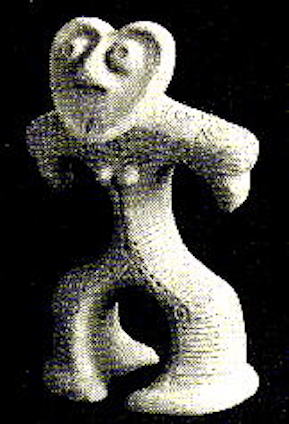 Fig. 4A8) Terracotta sculpture representing a man, perhaps a woman, since it has two small breasts, generally not found in male depictions.
Fig. 4A8) Terracotta sculpture representing a man, perhaps a woman, since it has two small breasts, generally not found in male depictions.
Size: very small.
Origin: Japan
Attribution: "Jomon Style 1"
.
In the third millennium (before and after) there existed an artistic language which was not preoccupied with imitating the real, but instead “invented” the figure (see also Fig. 4A7). This sculpture, besides containing several inventions, is also full of irony.
 Fig. 4A10) Wooden sculptures (drawing). Anthropomorphic and zoomorphic sculptures with pointed hats.
Fig. 4A10) Wooden sculptures (drawing). Anthropomorphic and zoomorphic sculptures with pointed hats.
Size: highest is 34 inches.
Origin: sacred forest of the Mugi, Siberia.
Dating: not more than 200 years old; they are recent.
They are Ostyak deities (sciaitàn). In our Paleolithic typology they represent (from right to left): a man, a mammal with a vertical human body and a bird with a vertical human body.
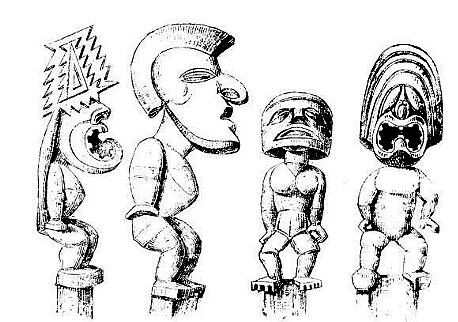 Fig. 4A12) Wooden sculptures (drawing). They are four contemporary deities of the same people: a man, a woman (with breasts), and two artistic man-animal hybrids.
Fig. 4A12) Wooden sculptures (drawing). They are four contemporary deities of the same people: a man, a woman (with breasts), and two artistic man-animal hybrids.
The man’s head is almost caricatural in style; the woman’s head is in geometric style, so different traditions are intended, even in style.
(Drawing from “Journey Around the World”, Venice, 1841).
Size: unknown.
Origin: Hawaiian Islands.
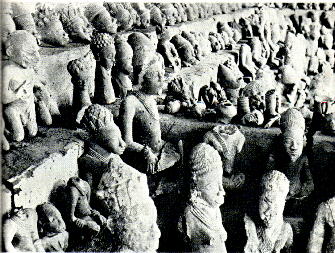 Fig. 4A13) A group of 800 soapstone sculptures discovered in Nigeria in 1934. The sculptures mainly depict men, mostly seated, wearing a variety of beautiful headdresses; there are also sculptures of women and animals.
Fig. 4A13) A group of 800 soapstone sculptures discovered in Nigeria in 1934. The sculptures mainly depict men, mostly seated, wearing a variety of beautiful headdresses; there are also sculptures of women and animals.
They were found in a forest and were deliberately damaged, probably for religious reasons.
Size: from 5.5 to 40 inches.
Origin: Esie, Florin province, Nigeria.
Dating: 1300 - 1500 A.D. approx.
.
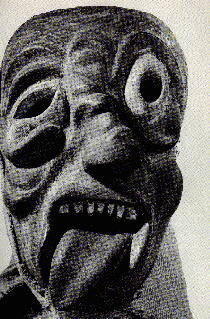 Fig.4A14) Wooden sculpture. It is a strongly ironic ritual mask which has roots in the Paleolithic, and intercontinental affinities, since one eye is different than the other and the tongue is protruding. It could represent half a face of a living person, and half a face of a dead one.
Fig.4A14) Wooden sculpture. It is a strongly ironic ritual mask which has roots in the Paleolithic, and intercontinental affinities, since one eye is different than the other and the tongue is protruding. It could represent half a face of a living person, and half a face of a dead one.
Origin: Grisons, Suisse.
Dating: probably last two centuries.
Location: National Museum of Ethnography, Munich, Germany.
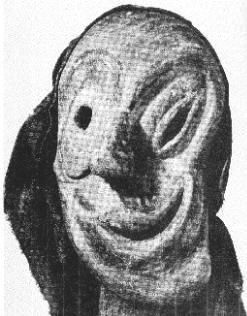 Fig.4A15) Wooden sculpture. Like the previous one, it is a strongly ironic ritual mask which has roots in the Paleolithic, and intercontinental affinities, since one eye is different than the other and the tongue is protruding. It could represent half a face of a living person, and half a face of a dead one.
Fig.4A15) Wooden sculpture. Like the previous one, it is a strongly ironic ritual mask which has roots in the Paleolithic, and intercontinental affinities, since one eye is different than the other and the tongue is protruding. It could represent half a face of a living person, and half a face of a dead one.
Origin: Grisons, Suisse.
Location: National Museum of Ethnography, Munich, Germany.
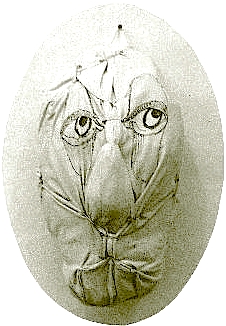 Fig. F1) Human head sculpture made with cloth, safety pins, paper and graphics.
Fig. F1) Human head sculpture made with cloth, safety pins, paper and graphics.
The imitation of the human head is exalted by the intense psychological expression of the gaze.
Height: 13.7 inches.
Artist: Licia Filingeri, Genoa, 1976.
Photo: Silvano Maggi, Milan, 1976.
 Fig. F2) Knickknack representing a clown in a typical circus style. The style of execution exaggerates the representation in a comic sense.
Fig. F2) Knickknack representing a clown in a typical circus style. The style of execution exaggerates the representation in a comic sense.
Observe the facial expression and hand gestures, which are absent in the doll (Fig. F3).
Colored blown glass.
Height: 9 inches.
Murano, Italy.
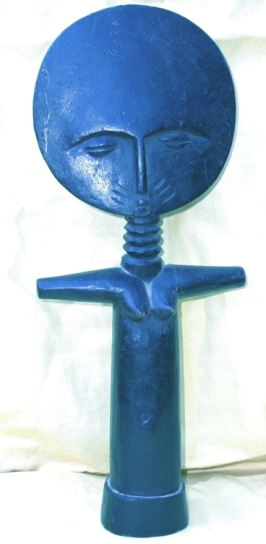 Fig. F3) Ritual fertility doll. Painted wooden sculpture.
Fig. F3) Ritual fertility doll. Painted wooden sculpture.
Probably executed between 1930 and 1950. It represents a woman, as it has two pointed breasts. The imitation of the human figure is remarkable, in geometric style and with details such as hands and ears removed from the body.
Height:13.3 inches.
Origin: Equatorial Africa.
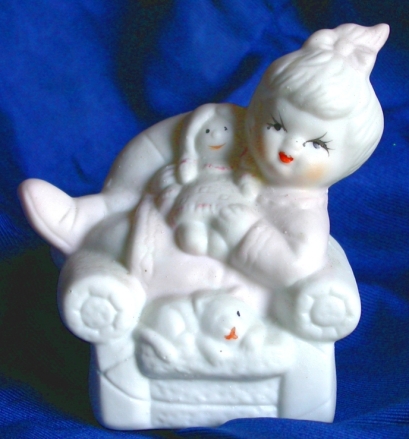 Fig. F 4) Knickknack. In knickknacks there is often great fantasy like in comics; people’s way of life is always reflected. The depiction of the girl with the doll actually shows a woman represented as a child. It is therefore a sort of artistic hybrid. The variations of form are remarkable, especially when compared with the clown’s movements (Fig. F 2). Porcelain, approx. 3.5 inches high.
Fig. F 4) Knickknack. In knickknacks there is often great fantasy like in comics; people’s way of life is always reflected. The depiction of the girl with the doll actually shows a woman represented as a child. It is therefore a sort of artistic hybrid. The variations of form are remarkable, especially when compared with the clown’s movements (Fig. F 2). Porcelain, approx. 3.5 inches high.
Dating: 1975 approx.
NEXT
Index
HOME PAGE
Page translated from Italian into English by Paris Alexander Walker.
Copyright©2020 by Museum of the Origins of Man, all rights reserved.

















